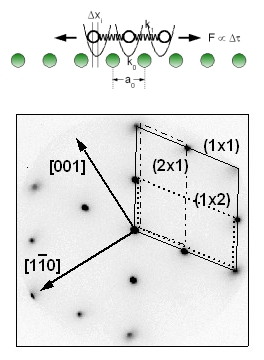
Elastic Effects on SurfacesOn surfaces, the bonds are modified, giving an excess stress. It is common that structural changes (such as a surface reconstruction) appear on the surface to relieve this stress. The consequences range from order-disorder (or order-order!) transitions, to mesoscopic patterns, to further modifications in the electronic/magnetic properties of the surface.
 Figure 1: The LEED pattern of a partially oxygen covered tungsten surface. Oxygen atoms show a (1x2) order, which gives rise to the half-order diffraction spots. The spot width gives the average size of the oxygen islands, and the average distance between the oxygen atoms can be extracted from the spot separations. The sketch above depicts the relaxation of the boundary atoms in a small adsorbate island [1].
Not surprisingly, surface stress is -partially- released at defects such as atomic steps. In a study combining low energy electron diffraction and density functional theory, we have shown that the boundary strains can be used to arrive at the elastic properties of the surface [1]. The same methodology gives information also on the temperature dependence of the surface elasticity. Interestingly, thermal expansion on a surface or adsorbate layer can be anisotropic, following the tensile/compressive nature of the original surface stress [2]. The elastic relaxation results in an energy gain, which is in competition with the energetic cost of step formation. As the range of influence of the two interactions are different, there is an optimum step separation for which the total energy is minimized. This simple story is the basis of a variety of periodic step patterns observed on crystal surfaces.
 Figure 1: Stress-induced Pd stripes on W(110) surface as a function of temperature. The regions covered with Pd monolayer appear bright. The temperature increases from Left to right [3].
An example to the formation of stress-induced periodic adsorbate steps is shown in figure 2. In our study, we showed that a submonolayer amount of Pd on W(110) surface spontaneously orders into stripes at elevated temperatures. Moreover the nature of the order-disorder transition is revealed by a comparison between the mesoscopic and atomic length scales [3]. The resulting patterns, aside from providing a model system to study phase transitions and ordering phenomena, constitute a stepping stone towards fabricating structures through self-assembly.
[1] T. O. Menteş, N. Stojić, N. Binggeli, M. A. Niņo, A. Locatelli, L. Aballe, M. Kiskinova, E. Bauer, "Strain relaxation in small adsorbate islands: O on W(110)", Phys. Rev. B 77, 155414 (2008). (A summary can be found here).
[2] N. Stojić, T. O. Menteş, N. Binggeli, M. A. Niņo, A. Locatelli, E. Bauer, "Temperature dependence of surface stress across an order-disorder transition: p(1x2)O/W(110)", Phys. Rev. B 81, 115437 (2010).
[3] T. O. Menteş, A. Locatelli, L. Aballe, E. Bauer, "Stress Induced Stripe Formation in Pd/W(110)", Phys. Rev. Lett. 101, 085701 (2008). (A summary can be found here). |
